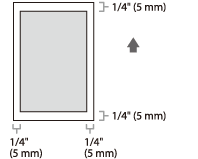Acceptable paper/original types and sizes
Available paper/original type and size are explained below.
Documents Requirements
|
Platen Glass |
ADF |
| Type |
Plain paper
Thick documents
Photographs
Small documents (e.g., index cards)
Special types of paper (e.g., tracing paper *1, transparencies *1, etc.)
Book (Height: Maximum 7/8" (20 mm)) |
Plain paper (multi-page documents of the same size, thickness and weight or onepage documents) |
| Size (W x L) |
Maximum 8 1/2" x 14"
(Maximum 216 mm x 356 mm) |
Maximum 8 1/2" x 14" (Maximum 215.9 x 355.6 mm)
Minimum 5 1/2" x 5" (Minimum 139.7 x 128 mm) |
| Weight |
Maximum 4.4 lb (2 kg) |
One-sided scanning (1 page): 13 to 28 lb (50 to 105 g/m2)
Two-sided scanning: 17 to 28 lb (64 to 105 g/m2) |
| Quantity |
1 sheet |
Maximum 50 sheets *2 (Maximum 30 sheets for LGL documents) *2 |
*1 When copying transparent documents such as tracing paper or transparencies, use a piece of plain white paper to cover the document after placing it face-down on the platen glass.
*2 21 lb (80 g/?) paper
Do not place the document on the platen glass or in the ADF until the glue, ink or correction fluid on the document is completely dry.
Remove all fasteners (staples, paper clips, etc.) before loading the documents in the ADF.
To prevent originals jams in the ADF, do not use any of the following:
- Wrinkled or creased paper
- Carbon paper or carbon-backed paper
- Curled or rolled paper
- Coated paper
- Torn paper
- Onion skin or thin paper
- Documents with staples or paper clips attached
- Paper printed with a thermal transfer printer
- Transparencies
Scanning Area
Make sure your document's text and graphics fall within the shaded area in the following diagram. Note that the margin widths listed are approximate and there may be slight variations in actual use.

Paper Requirements
|
Paper Cassette(s) |
Multi-purpose Tray |
| Size (W x L) |
LTR, LGL, A4, B5, A5, Executive, Oficio, Brazil-Oficio, Mexico-Oficio, FLSP, A-FLS, Government-LTR, Government-LGL |
3" x 5" to Legal (8 1/2" x 14") (76 x 127 to 216 x 356 mm) |
| Weight |
16 to 32 lb (60 to 120 g/m2) |
16 to 51 lb (60 to 190 g/m2) |
| Quantity |
500 sheets maximum *1 |
50 sheets maximum *1 |
| Type |
Plain Paper *2 |
O |
O |
| Plain Paper L *2 |
O |
O |
| Color *3 |
O |
O |
| Recycled *4 |
O |
O |
| Heavy Paper 1 |
O*5 |
O*6 |
| Heavy Paper 2 *7 |
- |
O |
| Transparency *8 |
- |
O |
| Labels |
- |
O |
| Envelope |
- |
O |
(O: available
-: not available)
*1 21 lb (80 g/m
2) paper
*2 From 16 to 21 lb (60 to 80 g/m
2)
*3 17 lb (64 g/m
2)
*4 From 17 to 21 lb (64 to 80 g/m
2)
*5 From 24 to 32 lb (90 to 120 g/m
2)
*6 From 24 to 40 lb (90 to 150 g/m
2)
*7 From 40 to 43 lb (151 to 163 g/m
2)
*8 Use only LTR or A4 transparencies made especially for this machine.
note:
The default paper size is LTR. If you use a different paper size, you need to change the paper size settings.
To prevent paper jams, do not use any of the following:
- Wrinkled or creased paper
- Curled or rolled paper
- Coated paper
- Torn paper
- Damp paper
- Very thin paper
- Paper which has been printed on using a thermal transfer printer (do not copy on the reverse side).
The following types of paper do not print well:
- Highly textured paper
- Very smooth paper
- Shiny paper
Make sure the paper is free from dust, lint, and oil stains.
Make sure to test paper before purchasing large quantities.
Store all paper wrapped and on a flat surface until ready for use. Keep opened packs in their original packaging in a cool, dry location.
Store paper at 64.4o-75.2oF (18o-24oC), 40%-60% relative humidity.
Use only the transparencies designed for laser printers. Canon recommends you to use Canon type transparencies with this machine.
Printable Area
The shaded area indicates the approximate printable area of LTR paper and envelope. Note that the margin widths listed are approximate and there may be slight variations in actual use.
